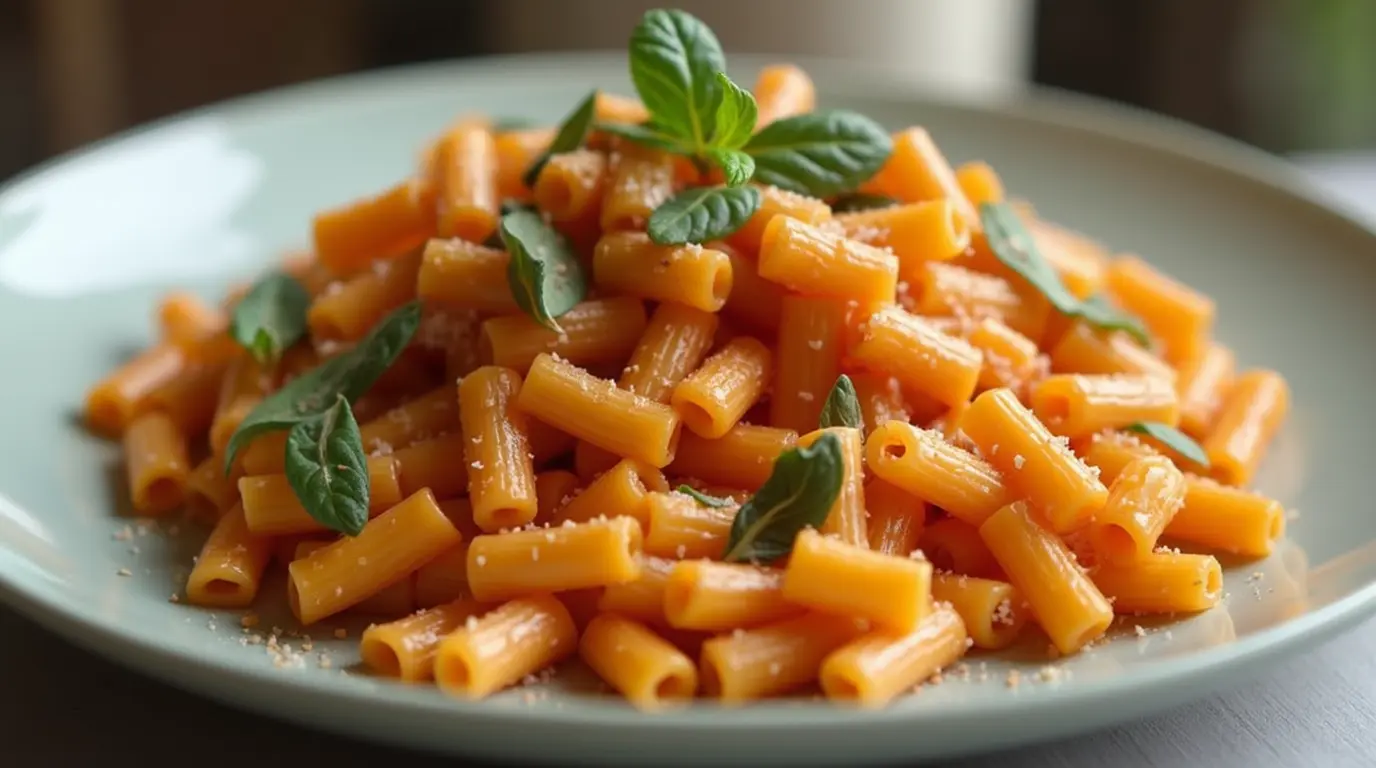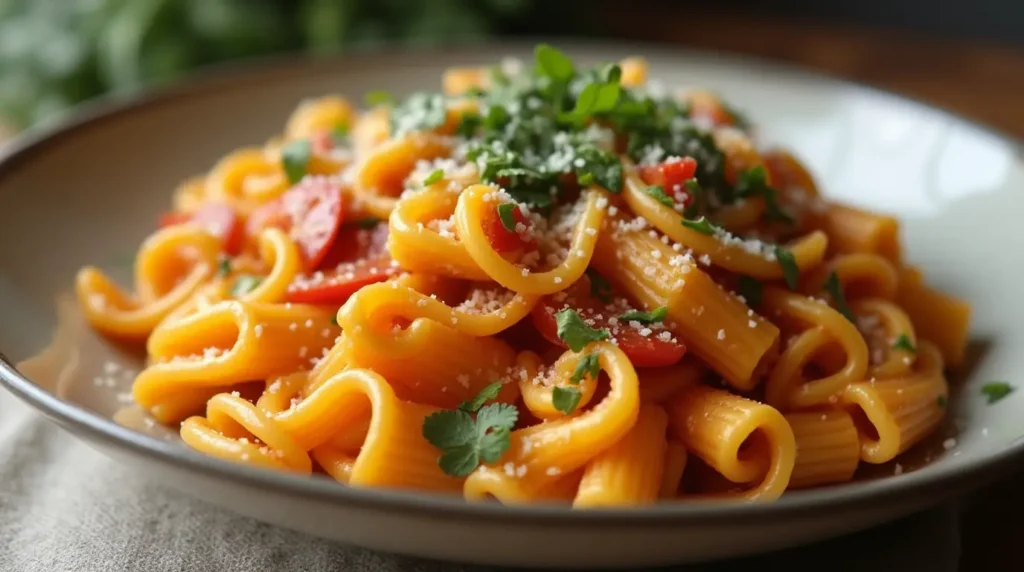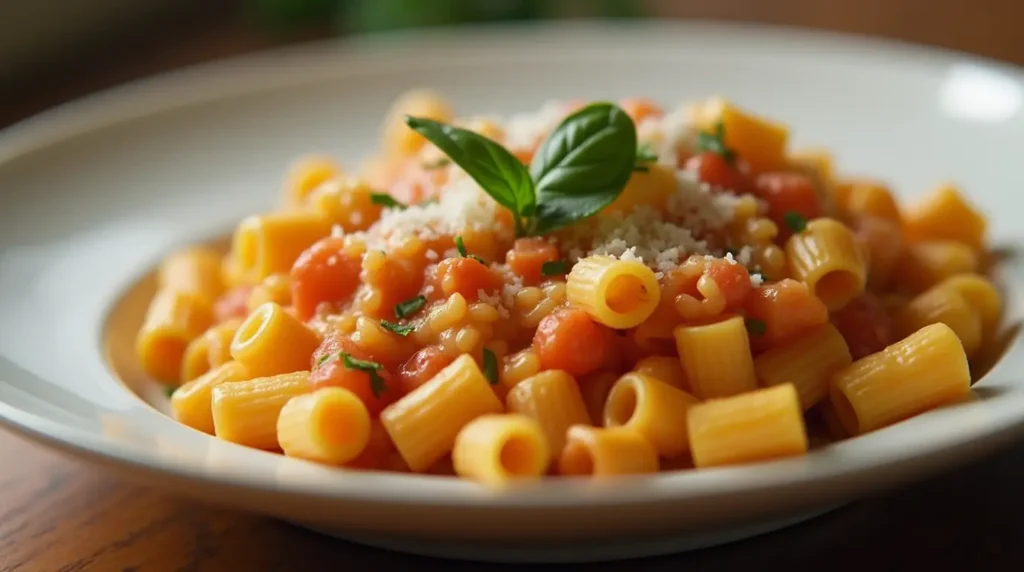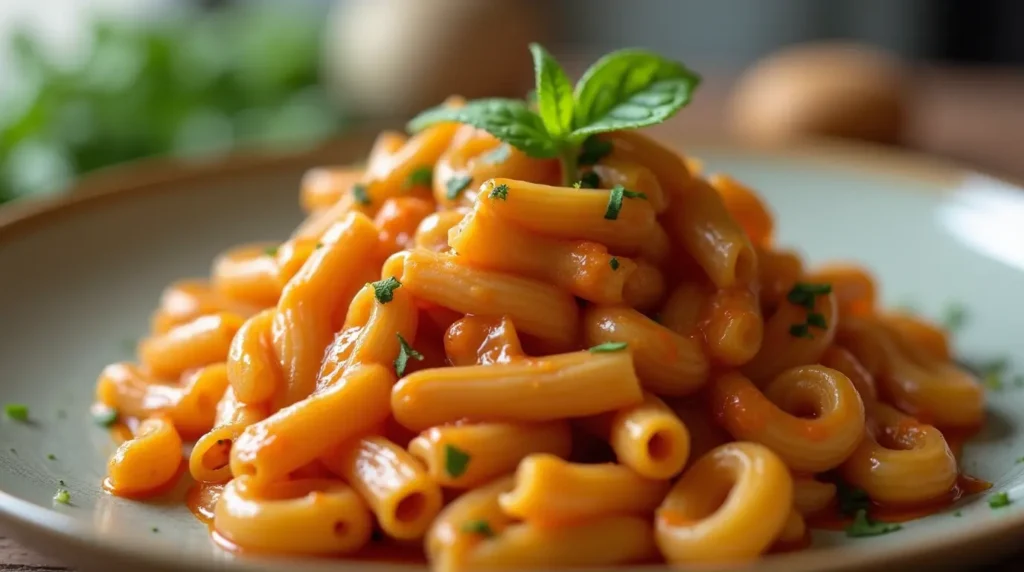How to Make Ditalini Pasta Recipe in 7 Simple Steps

Ditalini Pasta Recipe
Table of Contents
Have you ever looked at those cute little pasta tubes called ditalini and wondered what amazing dish they belong in? Do you crave a comforting, easy meal that warms you up from the inside out using simple ingredients you might already have? If you’re nodding along, then you’ve come to the perfect place! Forget complicated cooking – we’re about to unlock the secret to a truly satisfying ditalini pasta recipe that’s perfect for busy weeknights, cozy weekends, or anytime you need a bowl full of happiness. Get ready to learn how to make it in just 7 simple steps!
Overview: What Makes This Ditalini Pasta Recipe So Special?
This isn’t just about boiling pasta; we’re creating a complete, heartwarming dish where the ditalini pasta plays a starring role. Think of a thick, savory soup or a light stew, brimming with flavor, perhaps some beans or veggies, and those perfect little bites of pasta soaking up all the goodness. What makes this particular ditalini pasta recipe so wonderful?
- Super Comforting: It’s like a warm hug in a bowl. The combination of flavorful broth, tender pasta, and other simple ingredients is deeply satisfying.
- Quick & Easy: From start to finish, you can have this delicious meal on the table in about 30-40 minutes. The difficulty level is very low – ideal for beginner cooks or when you need dinner fast! This is a truly accessible ditalini pasta recipe.
- Wonderfully Versatile: We’ll focus on a classic, simple base (think tomato, beans, herbs), but this ditalini pasta recipe is incredibly easy to adapt. Add different veggies, use sausage, or make it spicy – it’s a fantastic starting point for your creativity!
- Perfect Pasta Bites: Ditalini means “little thimbles” in Italian, and their small size is perfect for soups and stews. They cook quickly and deliver just the right amount of pasta goodness in every spoonful without overwhelming the other ingredients. They are the ideal shape for this kind of ditalini pasta recipe.
- Ingredient Harmony: The simple components – savory broth, earthy beans, sweet tomatoes, aromatic herbs, and tender pasta – all work together beautifully to create a balanced and consistently delicious result.

Essential Ingredients: Building Your Delicious Ditalini Pasta Recipe
The magic of this ditalini pasta recipe comes from combining simple, quality ingredients. Here’s what you’ll typically need for a classic, comforting version:
- Ditalini Pasta: The star! About 1 cup (dry) is usually enough for a standard recipe serving around 4 people, especially when part of a soup or stew.
- Why Ditalini? Its small, tubular shape holds sauces and broth well, cooks quickly, and fits perfectly on a spoon with other ingredients. It’s the heart of this ditalini pasta recipe.
- Substitutions: If you can’t find ditalini, other small pasta shapes like small shells, elbow macaroni, or tubettini work well.
- Olive Oil: For sautéing the aromatics and building flavor. Extra virgin olive oil adds a nice fruity note.
- Aromatics – Onion & Garlic: The essential flavor base for almost any savory dish.
- Type: One medium yellow or white onion, finely diced. 2-4 cloves of fresh garlic, minced.
- Why It’s Important: Sautéing these first releases their sweetness and aroma, creating the foundation for your ditalini pasta recipe.
- Optional Veggie Base – Celery & Carrots (Mirepoix): Adding 1 diced celery stalk and 1 diced carrot along with the onion creates a classic mirepoix, adding subtle sweetness and depth. Highly recommended for a richer ditalini pasta recipe.
- Tomatoes: Tomatoes provide acidity, sweetness, color, and body.
- Best Choice: One large can (28 oz) of crushed or diced tomatoes (undrained). Crushed gives a smoother sauce, diced gives more texture. Tomato passata (purée) also works beautifully.
- Why Important: Tomatoes form the backbone of the sauce/broth in many traditional ditalini pasta recipe variations like Pasta e Fagioli.
- Broth: The liquid that brings everything together and cooks the pasta.
- Options: Vegetable broth (for vegetarian) or chicken broth. Use low-sodium if possible so you can control the saltiness. Around 4-6 cups are usually needed, depending on how soupy you like your ditalini pasta recipe.
- Beans: Beans add creaminess, protein, and fiber, making the dish more substantial.
- Classic Choices: One or two cans (15 oz each) of cannellini beans (white kidney beans) or borlotti beans (cranberry beans), rinsed and drained. Navy beans or Great Northern beans are also good substitutes.
- Why Important: Beans pair classicly with ditalini, adding heartiness and a lovely creamy texture when slightly mashed. They are key to many satisfying ditalini pasta recipe styles.
- Herbs & Seasonings: For that essential Italian flavor.
- Must-Haves: Dried oregano, dried basil, salt, and black pepper.
- Optional but Great: A pinch of red pepper flakes for gentle heat, a bay leaf added during simmering, and fresh rosemary or thyme sprigs (removed before serving). Fresh parsley or basil stirred in at the end adds brightness. Mastering the seasoning is key to a delicious ditalini pasta recipe.
- Optional Finishers: Grated Parmesan or Pecorino Romano cheese for serving, a drizzle of good quality olive oil.

Step-by-Step Instructions: Your 7 Steps to Ditalini Pasta Recipe Perfection
Ready to cook? Let’s break down this comforting ditalini pasta recipe into 7 easy-to-follow steps. We’ll assume we’re making a classic tomato-bean version and cooking the pasta right in the pot for maximum flavor infusion.
Step 1: Prep Your Ingredients (Mise en Place)
- Get Organized: Before you turn on the heat, prepare everything. Finely dice your onion, celery, and carrot (if using). Mince the garlic. Open your cans of tomatoes and beans (rinse and drain the beans). Measure out your broth and dry ditalini pasta. Have your herbs and seasonings handy.
- Why it Matters: This French technique called “mise en place” (everything in its place) makes the cooking process smooth, stress-free, and ensures you don’t forget anything in your ditalini pasta recipe. It prevents frantic chopping while things are burning!
Step 2: Sauté the Aromatics
- Heat the Oil: Place a large pot or Dutch oven over medium heat. Add 1-2 tablespoons of olive oil and let it warm up for a minute until it shimmers slightly.
- Cook the Veggies: Add the diced onion, celery, and carrot (if using) to the pot. Stir well and cook, stirring occasionally, for about 5-7 minutes, until the vegetables soften and the onion becomes translucent. Don’t rush this step; softening the veggies builds sweetness for your ditalini pasta recipe.
- Add Garlic: Stir in the minced garlic and cook for just another minute until it becomes fragrant. Be careful not to burn the garlic, as it can turn bitter. A sprinkle of salt and pepper here helps draw out moisture and season the base layer.
Step 3: Build the Flavor Base
- Tomatoes & Herbs: Pour in the can of crushed or diced tomatoes (undrained). Stir well, scraping up any browned bits from the bottom of the pot (that’s flavor!). Add your dried herbs – typically 1 teaspoon each of dried oregano and dried basil, plus a pinch of red pepper flakes if you like heat. Add a bay leaf if using. Stir everything together. This tomato and herb mixture is crucial for the taste profile of this ditalini pasta recipe.
- Add Broth: Pour in about 4 cups of vegetable or chicken broth. Stir everything well to combine.
Step 4: Simmer the Base
- Bring to a Simmer: Increase the heat slightly and bring the mixture to a gentle simmer (small bubbles breaking the surface). Don’t bring it to a rolling boil.
- Let Flavors Meld: Once simmering, reduce the heat to low, cover the pot loosely (leaving a small gap for steam to escape), and let the base cook for at least 10-15 minutes. This allows the flavors of the tomatoes, herbs, and aromatics to meld together beautifully, creating a richer foundation for your ditalini pasta recipe.
Step 5: Cook the Ditalini Pasta
- Increase Heat & Add Pasta: Remove the bay leaf (if used). Increase the heat back to medium to bring the soup back to a steady simmer. Add the dry ditalini pasta directly into the simmering liquid. Stir well to prevent sticking.
- Cook to Al Dente: Cook the pasta according to the package directions for “al dente” (usually around 7-10 minutes for ditalini), stirring occasionally. Al dente means “to the tooth” – the pasta should still have a slight, pleasant firmness in the center. Keep an eye on it, as small pasta shapes cook quickly! Cooking the pasta in the broth allows it to absorb flavor and release starch, which helps thicken the ditalini pasta recipe naturally.
- Liquid Check: If the mixture looks too thick as the pasta absorbs liquid, add more broth (up to the remaining 2 cups), about 1/2 cup at a time, until you reach your desired consistency. Remember, the pasta will continue to absorb liquid even after you turn off the heat.
Step 6: Add the Final Ingredients
- Stir in Beans: During the last 2-3 minutes of the pasta cooking time, stir in the rinsed and drained cannellini or borlotti beans. You just need to heat them through.
- Optional Creaminess Boost: For a creamier texture, you can take about half a cup of the beans, mash them roughly with a fork or immersion blender, and stir the mashed beans back into the pot. This adds body and richness to the ditalini pasta recipe.
- Optional Greens: If you want to add greens like chopped spinach, kale, or escarole, stir them in during the last minute or two of cooking, just until they wilt.
Step 7: Finish, Season, and Serve
- Turn Off Heat & Taste: Once the pasta is al dente and the beans are heated through (and greens wilted, if using), turn off the heat. Taste the soup carefully.
- Adjust Seasoning: Add salt and freshly ground black pepper totasteg. It will likely need a good pinch of salt, especially if you used low-sodium broth. This final seasoning step is critical for making your ditalini pasta recipe taste perfect.
- Final Touches: Stir in some fresh chopped parsley or basil for brightness, if desired.
- Serve Hot: Ladle the delicious ditalini pasta into bowls. Serve immediately, garnished with a generous sprinkle of grated Parmesan or Pecorino Romano cheese and an optional drizzle of extra virgin olive oil.

Assembly and Presentation Tips
Even a simple, rustic dish like this ditalini pasta recipe can look appealing!
- Bowls Matter: Serve in deep, comforting soup bowls. Earthy tones or simple white bowls work well.
- Garnish generously: Don’t skip the Parmesan! A good grating of cheese adds visual appeal and a salty, nutty flavor. Fresh herbs (parsley or basil) add a pop of green. The drizzle of olive oil creates beautiful golden pools on the surface.
- Texture Contrast: Serve with crusty bread on the side for dipping – it complements the texture of the soup and pasta perfectly. Garlic bread is also a fantastic companion to this ditalini pasta recipe.
- Family Style: For a casual meal, you can bring the whole pot to the table (if it’s presentable!) and let everyone serve themselves.
Storage and Make-Ahead Tips
This ditalini pasta recipe is delicious fresh, but leftovers are great, too,Here areh a couple of things to keep in mind:
- The Pasta Problem: Pasta cooked directly in soup or stew will continue to absorb liquid as it sits and cools, becoming softer and potentially making the dish very thick. This is the main challenge when storing this type of ditalini pasta recipe.
- Storage: Let the soup cool completely. Store leftovers in an airtight container in the refrigerator for up to 3-4 days.
- Reheating: Reheat gently on the stovetop over medium-low heat, stirring occasionally. You will likely need to add more broth, water, or even a splash of milk during reheating to loosen it back up to the desired consistency, as the pasta will have absorbed much of the liquid. Avoid boiling vigorously. You can also reheat individual portions in the microwave, stirring partway through.
- Make-Ahead Strategy:
- Option 1 (Best Texture): Make the soup base (Steps 1-4) completely. Cool and store it separately. When ready to serve, reheat the base, bring it to a simmer, and then cook the ditalini pasta in the soup (Step 5), adding the beans (Step 6) at the end. This keeps the pasta perfectly al dente. This method yields the best texture for your ditalini pasta recipe if it is made ahead.
- Option 2 (Easier): Make the entire recipe, understanding the pasta will soften upon storage. Just be prepared to add extra liquid when reheating.
- Freezing: You can freeze the soup base (without pasta or beans added) very well. Thaw, reheat, then add freshly cooked pasta and beans. Freezing the completed dish with pasta is possible, but the pasta texture will likely be very soft upon thawing and reheating.
Creative Ditalini Pasta Recipe Variations
This simple ditalini pasta recipe is a fantastic canvas! Try these variations:
- Add Meat: Brown some Italian sausage (casings removed), ground beef, or pancetta, along with the onions in Step 2. Drain excess fat before proceeding. This adds savory depth.
- More Veggies: Bulk it up with diced zucchini, bell peppers, mushrooms, or potatoes added along with the aromatics or during the simmering phase (depending on cook time).
- Creamy Version: Stir in a splash of heavy cream or half-and-half at the very end (Step 7, with heat off) for a richer, creamier broth. A dollop of mascarpone or cream cheese melted in also works wonders for a creamy ditalini pasta recipe.
- Spicy Kick: Add more red pepper flakes, a diced fresh chili pepper with the aromatics, or a spoonful of Calabrian chili paste.
- Lemon & Greens: Add lots of leafy greens (kale, spinach, escarole) and finish with a squeeze of fresh lemon juice and zest for a brighter, slightly different ditalini pasta recipe.
- Pesto Swirl: Stir a spoonful of basil pesto into each bowl just before serving for a burst of fresh, herbaceous flavor.
Conclusion: Enjoy Your Bowl of Comfort!
There you have it – a simple, satisfying, and incredibly versatile ditalini pasta recipe broken down into 7 easy steps. This dish proves that you don’t need complicated techniques or expensive ingredients to create something truly delicious and comforting. It’s a recipe that’s perfect for customizing, whether you stick to the classic tomato and bean combination or venture out with added meats, veggies, or spices. S, next time you’re looking for a quick, heartwarming meal, remember this easy ditalini pasta recipe. Grab your pot, gather your simple ingredients, and enjoy creating (and eating!) your very own bowl of pasta perfection. Happy cooking!
Frequently Asked Questions (FAQs)
Q1: Can I cook the ditalini pasta separately and add it at the end?
- A: Absolutely! This is a great option if you prefer firmer pasta, plan on having leftovers (as the pasta won’t get as mushy), or want more control over the soup’s consistency. Cook the ditalini in salted water according to package directions, drain it well, and stir it into the finished soup base just before serving, or add it to individual bowls and ladle the soup over it. This changes the final texture slightly but is a valid approach to a ditalini pasta recipe.
Q2: Why is my ditalini pasta recipe so thick after storing it?
- A: The pasta acts like a sponge! As it sits in the liquid, it continues to absorb moisture, making the soup thicker and the pasta softer. This is normal. Simply add more broth or water when reheating to reach your desired consistency again.
Q3: Can I use dried beans instead of canned?
- A: Yes, but you’ll need to plad. Dried beans need to be soaked overnight and then cooked separately until tender before you add them to the soup (usually added in Step 6, just like canned beans). Using dried beans can add even more flavor to your ditalini pasta recipe, but it significantly increases the preparation time.
Q4: Is this ditalini pasta recipe healthy?
- A: It certainly can be! It’s packed with vegetables, fiber-rich beans, and complex carbohydrates from the pasta (especially if you choose whole wheat ditalini). Using lean protein options (like beans or chicken broth instead of sausage) and controlling the amount of cheese and oil keeps it balanced. This ditalini pasta recipe offers a good mix of nutrients and is quite satisfying.
Q5: What’s the difference between ditalini and tubettini?
- A: They are very similar small, tubular pasta shapes! Ditalini (“little thimbles”) are generally slightly shorter and might be wider than tubettini (“little tubes”). In most recipes, including this ditalini pasta recipe, they can be used interchangeably without any noticeable difference.
Q6: Can I make this ditalini pasta recipe gluten-free?
- A: Yes! Simply substitute the regular ditalini pasta with your favorite gluten-free small pasta shape. Cook according to the package directions for the gluten-free pasta, keeping in mind they sometimes cook faster or absorb liquid differently. Ensure your broth and other canned goods are also certified gluten-free.
Key Citations
- Easy Pasta Fagioli Recipe with Ditalini
- Pasta e Fagioli (Italian Pasta and Beans) Recipe
- Authentic Pasta Fagioli Recipe with Step-by-Step Video
- Pasta e Fagioli Recipe with Ditalini
- Pasta Fagioli Soup Better than Olive Garden’s
- Pasta e Fagioli Recipe NYT Cooking
- Olive Garden Pasta e Fagioli Copycat Recipe
- Instant Pot Pasta e Fagioli Recipe
- Pasta e Fagioli Soup Recipe with Beans and Veggies
- Pasta e Fagioli Soup Recipe The Cookie Rookie
Source Links
- Loaded Potato Casserole Recipe Kim J: How to Make It Perfect https://ghitarecipes.com/loaded-potato-casserole-recipe-kim-j/
- Chicken Dressing Recipe: How to Elevate Your Holiday Meal https://ghitarecipes.com/chicken-dressing-recipe/
- Best Tofu Marinade Chicken Recipes: How to Make Them Tasty https://ghitarecipes.com/best-tofu-marinade-chicken-recipes/
- Baked Chicken Cutlet Recipes: How to Make Them Crispy https://ghitarecipes.com/best-tofu-marinade-chicken-recipes/
- Spark Recipes Chicken Taco Soup: How to Make It Flavorful https://ghitarecipes.com/spark-recipes-chicken-taco-soup/
- Diabetic Recipe for Crock Pot Soup with Chicken: How to Serve It https://ghitarecipes.com/diabetic-recipe-for-crock-pot-soup-with-chicken/
- Famous Recipe Chicken Near Me: How to Find the Best Spots https://ghitarecipes.com/famous-recipe-chicken-near-me/
- How to Make the Best Diabetic Crockpot Recipes Gnocchi and Chicken in 5 Steps https://ghitarecipes.com/diabetic-crockpot-recipes-gnocchi-and-chicken-2/
- How to Make the Best Chicken Philly Cheesesteak Recipe in 5 Steps https://ghitarecipes.com/chicken-philly-cheesesteak-recipe/
- Chicken and Cheese Jalousie Recipe: 5 Easy Steps to Make https://ghitarecipes.com/chicken-and-cheese-jalousie-recipe/
- How to Make the Best Chick Fil A Kale Salad Recipe in 5 Steps https://ghitarecipes.com/chick-fil-a-kale-salad-recipe/
- 7 Best Blackstone Chicken Recipes You Need to Try This Season https://ghitarecipes.com/blackstone-chicken-recipes/
- 7 Secrets Behind the Perfect Ground Chicken Mexican Corn Recipe https://ghitarecipes.com/ground-chicken-mexican-corn-recipe-2/
- Why This 3-Ingredient Recipe for Pasta Fazool Made with Chicken Is a Game Changer https://ghitarecipes.com/pasta-fazool-made-with-chicken/
- Braised Chicken in the Oven with Crispy Skin Recipe: 7 Flavor Boosters https://ghitarecipes.com/braised-chicken-in-the-oven-with-crispy-skin/
- Best 7 Ways to Use Chicken_and_cheese_filling in Your Dishes https://ghitarecipes.com/chicken-and-cheese-filling/
- Chicken and Gravy Recipe: How to Make It in 30 Minutes https://ghitarecipes.com/chicken-and-gravy-recipe/






